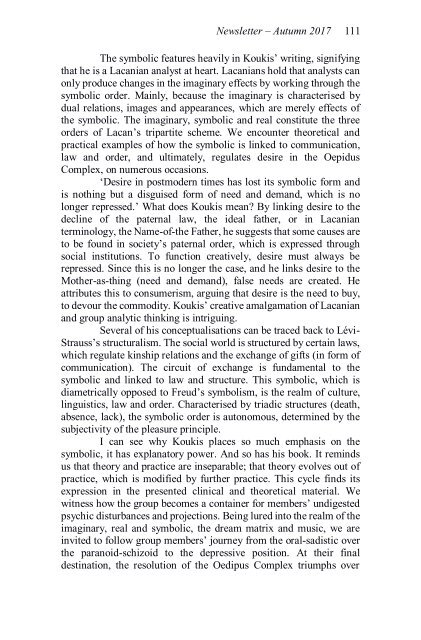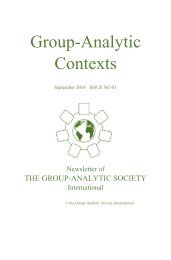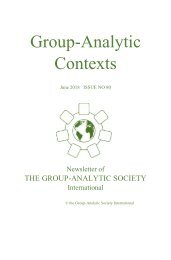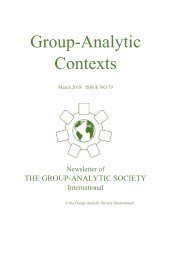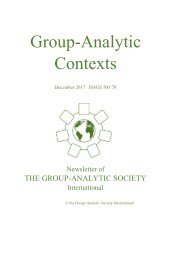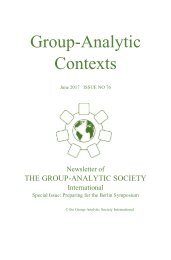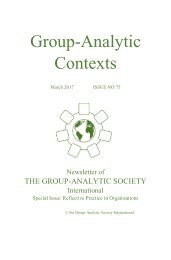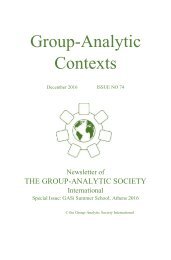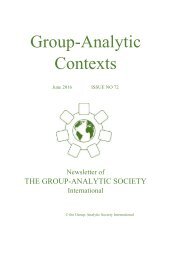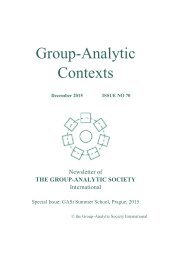Group Analytic Contexts, Issue 77, September 2017
Newsletter of the Group Analytic Society International
Newsletter of the Group Analytic Society International
You also want an ePaper? Increase the reach of your titles
YUMPU automatically turns print PDFs into web optimized ePapers that Google loves.
Newsletter – Autumn <strong>2017</strong> 111<br />
The symbolic features heavily in Koukis’ writing, signifying<br />
that he is a Lacanian analyst at heart. Lacanians hold that analysts can<br />
only produce changes in the imaginary effects by working through the<br />
symbolic order. Mainly, because the imaginary is characterised by<br />
dual relations, images and appearances, which are merely effects of<br />
the symbolic. The imaginary, symbolic and real constitute the three<br />
orders of Lacan’s tripartite scheme. We encounter theoretical and<br />
practical examples of how the symbolic is linked to communication,<br />
law and order, and ultimately, regulates desire in the Oepidus<br />
Complex, on numerous occasions.<br />
‘Desire in postmodern times has lost its symbolic form and<br />
is nothing but a disguised form of need and demand, which is no<br />
longer repressed.’ What does Koukis mean? By linking desire to the<br />
decline of the paternal law, the ideal father, or in Lacanian<br />
terminology, the Name-of-the Father, he suggests that some causes are<br />
to be found in society’s paternal order, which is expressed through<br />
social institutions. To function creatively, desire must always be<br />
repressed. Since this is no longer the case, and he links desire to the<br />
Mother-as-thing (need and demand), false needs are created. He<br />
attributes this to consumerism, arguing that desire is the need to buy,<br />
to devour the commodity. Koukis’ creative amalgamation of Lacanian<br />
and group analytic thinking is intriguing.<br />
Several of his conceptualisations can be traced back to Lévi-<br />
Strauss’s structuralism. The social world is structured by certain laws,<br />
which regulate kinship relations and the exchange of gifts (in form of<br />
communication). The circuit of exchange is fundamental to the<br />
symbolic and linked to law and structure. This symbolic, which is<br />
diametrically opposed to Freud’s symbolism, is the realm of culture,<br />
linguistics, law and order. Characterised by triadic structures (death,<br />
absence, lack), the symbolic order is autonomous, determined by the<br />
subjectivity of the pleasure principle.<br />
I can see why Koukis places so much emphasis on the<br />
symbolic, it has explanatory power. And so has his book. It reminds<br />
us that theory and practice are inseparable; that theory evolves out of<br />
practice, which is modified by further practice. This cycle finds its<br />
expression in the presented clinical and theoretical material. We<br />
witness how the group becomes a container for members’ undigested<br />
psychic disturbances and projections. Being lured into the realm of the<br />
imaginary, real and symbolic, the dream matrix and music, we are<br />
invited to follow group members’ journey from the oral-sadistic over<br />
the paranoid-schizoid to the depressive position. At their final<br />
destination, the resolution of the Oedipus Complex triumphs over


